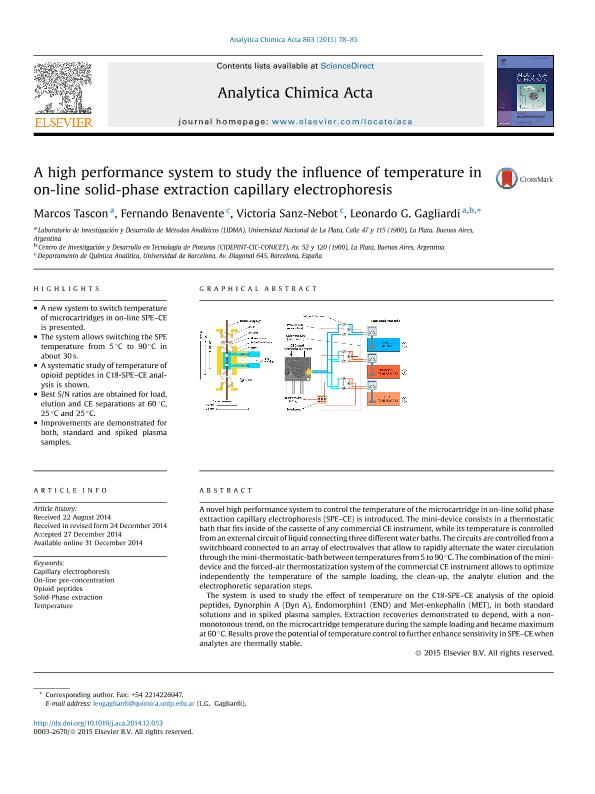Mostrar el registro sencillo del ítem
dc.contributor.author
Tascon, Marcos

dc.contributor.author
Benavente Moreno, Fernando J.
dc.contributor.author
Sanz Nebot, Victoria
dc.contributor.author
Gagliardi, Leonardo Gabriel

dc.date.available
2017-03-10T21:07:41Z
dc.date.issued
2015-03
dc.identifier.citation
Tascon, Marcos; Benavente Moreno, Fernando J. ; Sanz Nebot, Victoria; Gagliardi, Leonardo Gabriel; A high performance system to study the influence of temperature in on-line solid-phase extraction capillary electrophoresis; Elsevier Science; Analytica Chimica Acta; 863; 3-2015; 78-85
dc.identifier.issn
0003-2670
dc.identifier.uri
http://hdl.handle.net/11336/13741
dc.description.abstract
A novel high performance system to control the temperature of the microcartridge in on-line solid phase extraction capillary electrophoresis (SPE–CE) is introduced. The mini-device consists in a thermostatic bath that fits inside of the cassette of any commercial CE instrument, while its temperature is controlled from an external circuit of liquid connecting three different water baths. The circuits are controlled from a switchboard connected to an array of electrovalves that allow to rapidly alternate the water circulation through the mini-thermostatic-bath between temperatures from 5 to 90 °C. The combination of the mini-device and the forced-air thermostatization system of the commercial CE instrument allows to optimize independently the temperature of the sample loading, the clean-up, the analyte elution and the electrophoretic separation steps. The system is used to study the effect of temperature on the C18-SPE–CE analysis of the opioid peptides, Dynorphin A (Dyn A), Endomorphin1 (END) and Met-enkephalin (MET), in both standard solutions and in spiked plasma samples. Extraction recoveries demonstrated to depend, with a non-monotonous trend, on the microcartridge temperature during the sample loading and became maximum at 60 °C. Results prove the potential of temperature control to further enhance sensitivity in SPE–CE when analytes are thermally stable.
dc.format
application/pdf
dc.language.iso
eng
dc.publisher
Elsevier Science

dc.rights
info:eu-repo/semantics/openAccess
dc.rights.uri
https://creativecommons.org/licenses/by-nc-nd/2.5/ar/
dc.subject
Capillary Electrophoresis
dc.subject
On-Line Pre-Concentration
dc.subject
Opioid Peptides
dc.subject
Solid-Phase Extraction
dc.subject.classification
Química Analítica

dc.subject.classification
Ciencias Químicas

dc.subject.classification
CIENCIAS NATURALES Y EXACTAS

dc.title
A high performance system to study the influence of temperature in on-line solid-phase extraction capillary electrophoresis
dc.type
info:eu-repo/semantics/article
dc.type
info:ar-repo/semantics/artículo
dc.type
info:eu-repo/semantics/publishedVersion
dc.date.updated
2017-03-08T15:40:08Z
dc.journal.volume
863
dc.journal.pagination
78-85
dc.journal.pais
Países Bajos

dc.journal.ciudad
Amsterdam
dc.description.fil
Fil: Tascon, Marcos. Universidad Nacional de La Plata. Facultad de Ciencias Exactas. Laboratorio de Investigación y Desarrollo de Métodos Analíticos; Argentina. Consejo Nacional de Investigaciones Científicas y Técnicas; Argentina
dc.description.fil
Fil: Benavente Moreno, Fernando J.. Universidad de Barcelona; España
dc.description.fil
Fil: Sanz Nebot, Victoria. Universidad de Barcelona; España
dc.description.fil
Fil: Gagliardi, Leonardo Gabriel. Universidad Nacional de La Plata. Facultad de Ciencias Exactas. Laboratorio de Investigación y Desarrollo de Métodos Analíticos; Argentina. Consejo Nacional de Investigaciones Científicas y Técnicas. Centro Científico Tecnológico La Plata. Centro de Investigación y Desarrollo en Tecnología de Pinturas (i); Argentina. Provincia de Buenos Aires. Gobernación. Comisión de Investigaciones Científicas; Argentina
dc.journal.title
Analytica Chimica Acta

dc.relation.alternativeid
info:eu-repo/semantics/altIdentifier/doi/http://dx.doi.org/10.1016/j.aca.2014.12.053
dc.relation.alternativeid
info:eu-repo/semantics/altIdentifier/url/http://www.sciencedirect.com/science/article/pii/S0003267014014913
Archivos asociados
